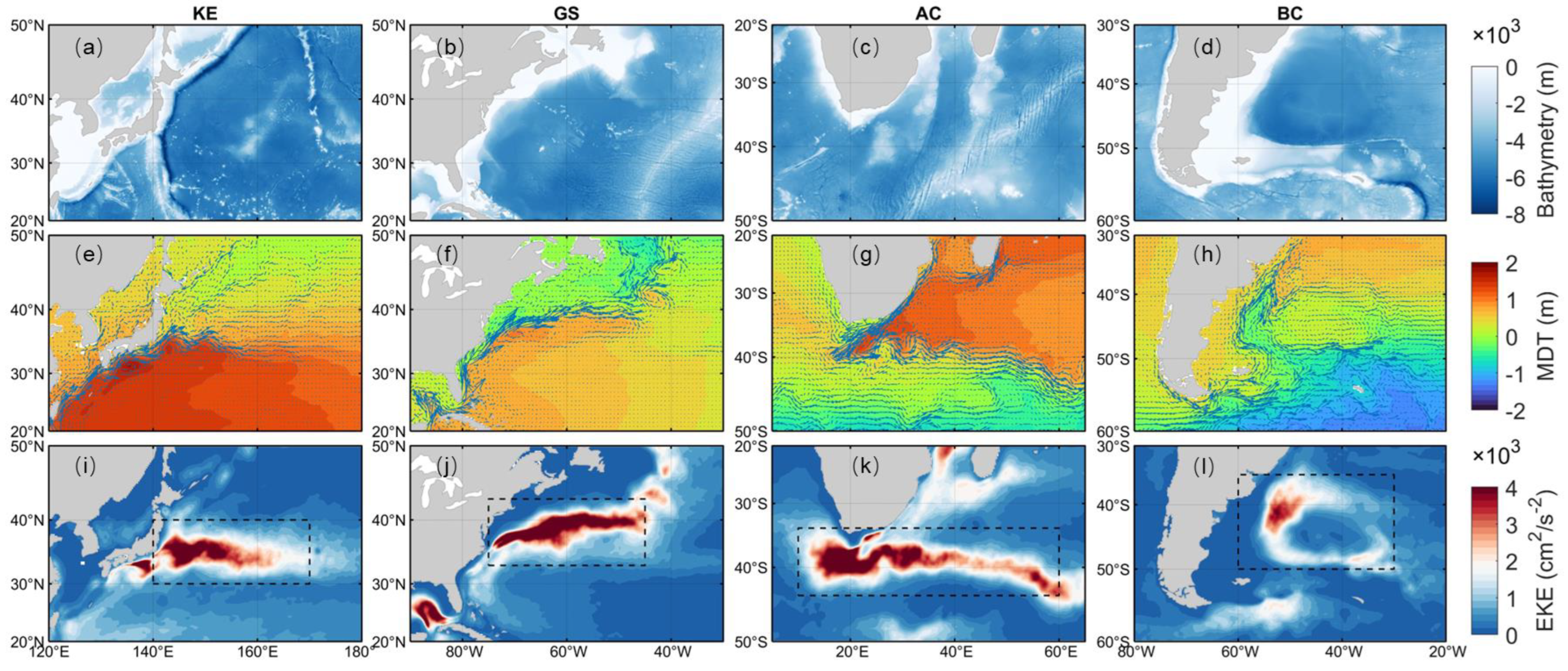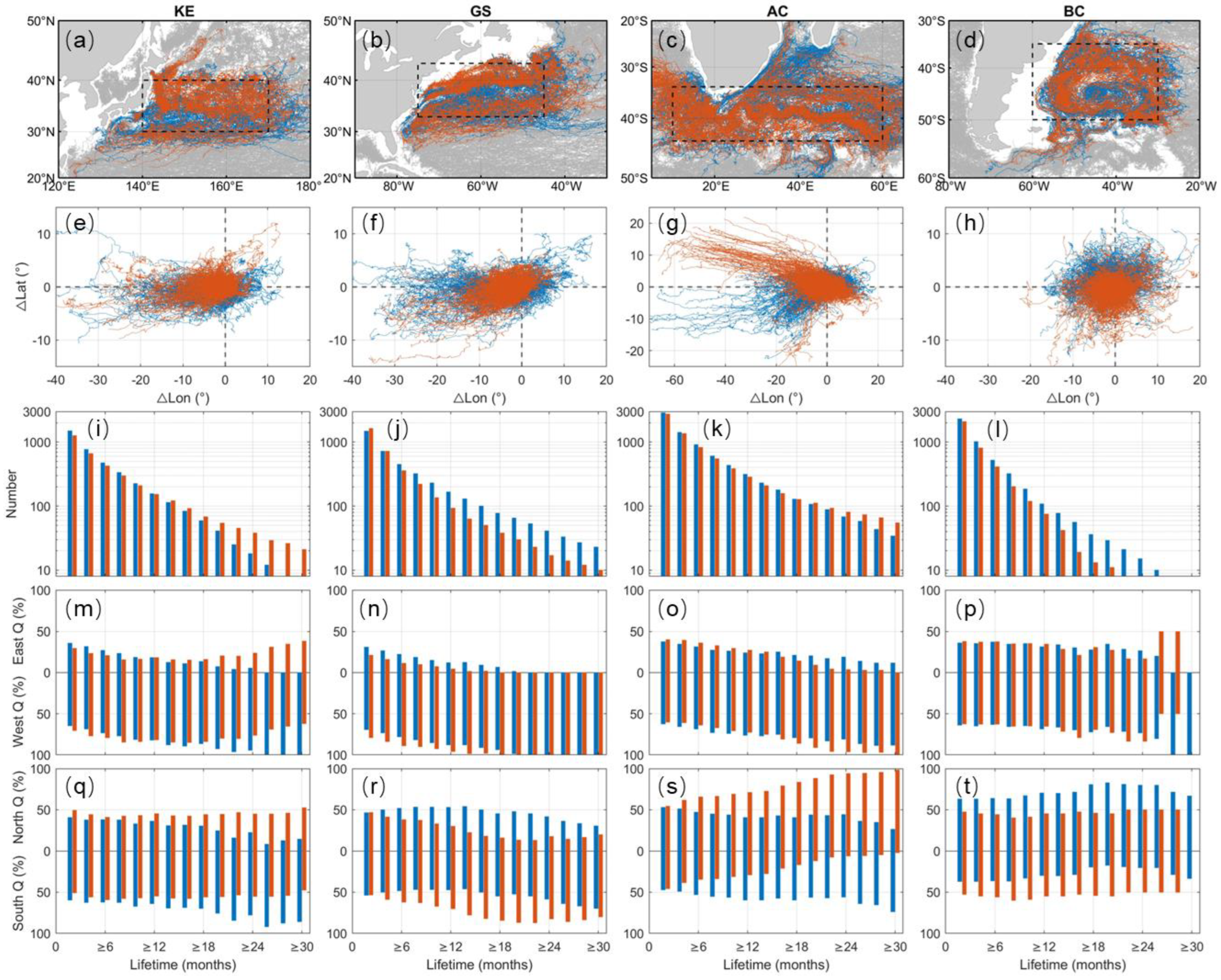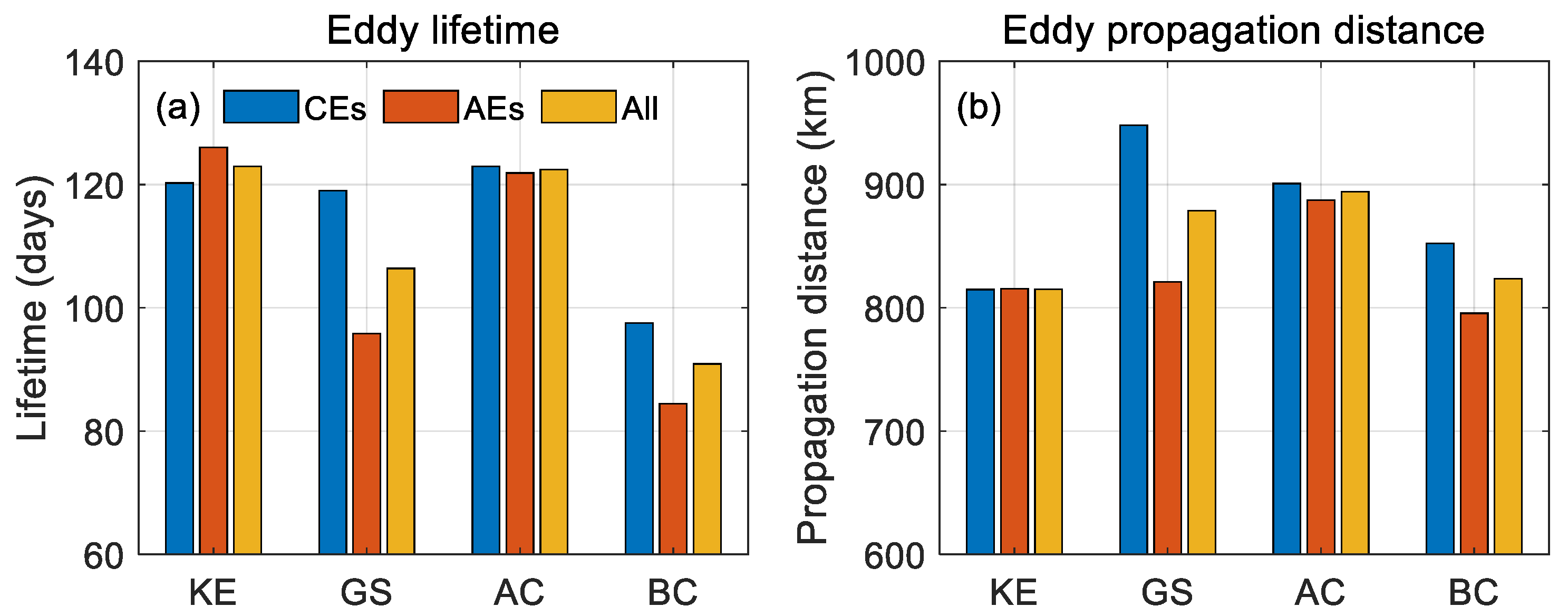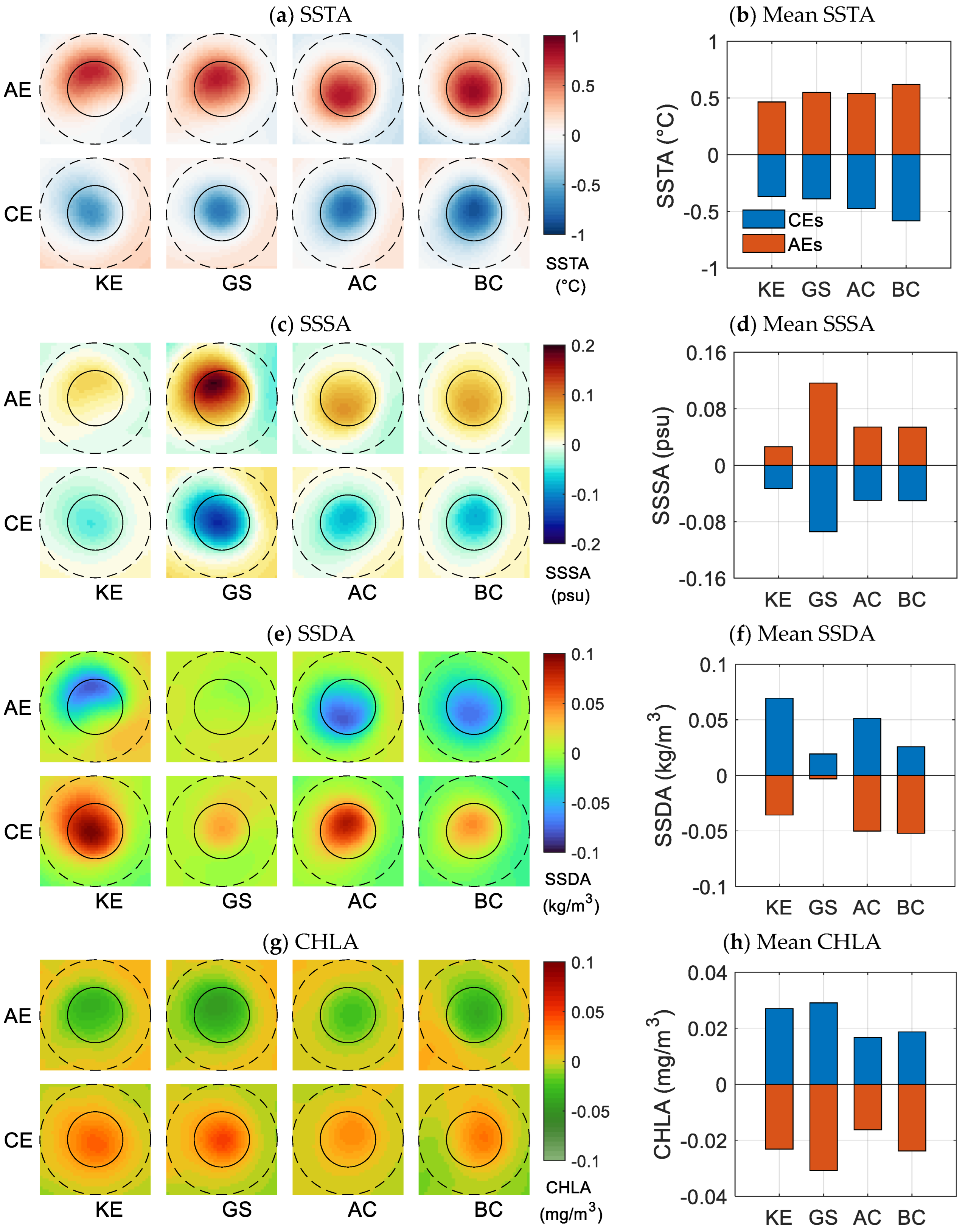Mesoscale Eddy Properties in Four Major Western Boundary Current Regions
Abstract
1. Introduction
2. Materials and Methods
2.1. Data
2.1.1. The Multi-Altimeter Merged SSHA Product
2.1.2. The NOAA OISST Product
2.1.3. The Sea Surface Salinity and Density Product
2.1.4. The Global Ocean Color Product
2.1.5. Argo Profiles Data
2.2. Eddy Identification and Tracking
2.3. Eddy Surface and Vertical Signals
3. Results
3.1. Eddy Trajectory, Lifetime, and Propagation Distance
3.2. Geographical Distributions of Eddy Number, Polarity, Amplitude, and Radius
4. Discussion
4.1. Characteristics of Surface Temperature, Salinity, Density, and Chlorophyll Concentration of Mesoscale Eddies
4.2. Vertical Thermohaline Characteristics of Mesoscale Eddies in the Four WBCs
5. Conclusions
Author Contributions
Funding
Data Availability Statement
Acknowledgments
Conflicts of Interest
References
- Fu, L.-L.; Cazenave, A. Satellite Altimetry and Earth Sciences: A Handbook of Techniques and Applications (Google EBook). In Satellite Altimetry and Earth Sciences A Handbook of Techniques and Applications; Academic Press: Cambridge, MA, USA, 2000. [Google Scholar]
- Chelton, D.B.; Schlax, M.G.; Samelson, R.M. Global Observations of Nonlinear Mesoscale Eddies. Prog. Oceanogr. 2011, 91, 167–216. [Google Scholar] [CrossRef]
- Faghmous, J.H.; Frenger, I.; Yao, Y.; Warmka, R.; Lindell, A.; Kumar, V. A Daily Global Mesoscale Ocean Eddy Dataset from Satellite Altimetry. Sci. Data 2015, 2, 150028. [Google Scholar] [CrossRef]
- Dong, C.; Liu, L.; Nencioli, F.; Bethel, B.J.; Liu, Y.; Xu, G.; Ma, J.; Ji, J.; Sun, W.; Shan, H.; et al. The Near-Global Ocean Mesoscale Eddy Atmospheric-Oceanic-Biological Interaction Observational Dataset. Sci. Data 2022, 9, 436. [Google Scholar] [CrossRef]
- Ferrari, R.; Wunsch, C. Ocean Circulation Kinetic Energy: Reservoirs, Sources, and Sinks. Annu. Rev. Fluid Mech. 2009, 41, 253–282. [Google Scholar] [CrossRef]
- Zhang, Z.; Wang, W.; Qiu, B. Oceanic Mass Transport by Mesoscale Eddies. Science 2014, 345, 322–324. [Google Scholar] [CrossRef]
- Xu, C.; Shang, X.D.; Huang, R.X. Estimate of Eddy Energy Generation/Dissipation Rate in the World Ocean from Altimetry Data. Ocean Dyn. 2011, 61, 525–541. [Google Scholar] [CrossRef]
- Klein, P.; Lapeyre, G. The Oceanic Vertical Pump Induced by Mesoscale and Submesoscale Turbulence. Annu. Rev. Mar. Sci. 2009, 1, 351–375. [Google Scholar] [CrossRef]
- McGillicuddy, D.J. Mechanisms of Physical-Biological-Biogeochemical Interaction at the Oceanic Mesoscale. Annu. Rev. Mar. Sci. 2016, 8, 125–159. [Google Scholar] [CrossRef] [PubMed]
- Xu, L.; Li, P.; Xie, S.P.; Liu, Q.; Liu, C.; Gao, W. Observing Mesoscale Eddy Effects on Mode-Water Subduction and Transport in the North Pacific. Nat. Commun. 2016, 7, 10505. [Google Scholar] [CrossRef]
- Mathis, J.T.; Pickart, R.S.; Hansell, D.A.; Kadko, D.; Bates, N.R. Eddy Transport of Organic Carbon and Nutrients from the Chukchi Shelf: Impact on the Upper Halocline of the Western Arctic Ocean. J. Geophys. Res. Oceans 2007, 112, C05011. [Google Scholar] [CrossRef]
- Dong, C.; McWilliams, J.C.; Liu, Y.; Chen, D. Global Heat and Salt Transports by Eddy Movement. Nat. Commun. 2014, 5, 3294. [Google Scholar] [CrossRef] [PubMed]
- Maúre, E.R.; Ishizaka, J.; Sukigara, C.; Mino, Y.; Aiki, H.; Matsuno, T.; Tomita, H.; Goes, J.I.; Gomes, H.R. Mesoscale Eddies Control the Timing of Spring Phytoplankton Blooms: A Case Study in the Japan Sea. Geophys. Res. Lett. 2017, 44, 11115–11124. [Google Scholar] [CrossRef]
- Bian, C.; Jing, Z.; Wang, H.; Wu, L.; Chen, Z.; Gan, B.; Yang, H. Oceanic Mesoscale Eddies as Crucial Drivers of Global Marine Heatwaves. Nat. Commun. 2023, 14, 2970. [Google Scholar] [CrossRef]
- Zu, Y.; Fang, Y.; Sun, S.; Gao, L.; Yang, Y.; Guo, G. Seasonal Variation of Mesoscale Eddy Intensity in the Global Ocean. Acta Oceanol. Sin. 2024, 43, 48–58. [Google Scholar] [CrossRef]
- Zhai, X.; Johnson, H.L.; Marshall, D.P. Significant Sink of Ocean-Eddy Energy near Western Boundaries. Nat. Geosci. 2010, 3, 608–612. [Google Scholar] [CrossRef]
- Tang, B.; Hou, Y.; Yin, Y.; Hu, P. Probability Distributions of Statistical Characteristics of Mesoscale Eddies in the Global Ocean. Int. J. Remote Sens. 2019, 40, 6283–6297. [Google Scholar] [CrossRef]
- Richardson, P.L. Gulf Stream Rings. In Eddies in Marine Science; Robinson, A.R., Ed.; Springer: Berlin/Heidelberg, Germany, 1983; pp. 19–45. [Google Scholar]
- Talley, L.D.; Pickard, G.L.; Emery, W.J.; Swift, J.H. Descriptive Physical Oceanography: An Introduction, 6th ed.; Academic Press: Cambridge, MA, USA, 2011. [Google Scholar]
- Beal, L.M.; Bryden, H.L. The Velocity and Vorticity Structure of the Agulhas Current at 32°S. J. Geophys. Res. Oceans 1999, 104, 5151–5176. [Google Scholar] [CrossRef]
- Beal, L.M.; Elipot, S.; Houk, A.; Leber, G.M. Capturing the Transport Variability of a Western Boundary Jet: Results from the Agulhas Current Time-Series Experiment (ACT). J. Phys. Oceanogr. 2015, 45, 1302–1324. [Google Scholar] [CrossRef]
- Beal, L.M.; De Ruijter, W.P.M.; Biastoch, A.; Zahn, R.; Cronin, M.; Hermes, J.; Lutjeharms, J.; Quartly, G.; Tozuka, T.; Baker-Yeboah, S.; et al. On the Role of the Agulhas System in Ocean Circulation and Climate. Nature 2011, 472, 429–436. [Google Scholar] [CrossRef]
- Lutjeharms, J.R.E.; Van Ballegooyen, R.C. The Retroflection of the Agulhas Current. J. Phys. Oceanogr. 1988, 18, 1570–1583. [Google Scholar] [CrossRef]
- Richardson, P.L. Agulhas Leakage into the Atlantic Estimated with Subsurface Floats and Surface Drifters. Deep Sea Res. Part I Oceanogr. Res. Pap. 2007, 54, 1361–1389. [Google Scholar] [CrossRef]
- Wei, L.; Wang, C. Characteristics of Ocean Mesoscale Eddies in the Agulhas and Tasman Leakage Regions from Two Eddy Datasets. Deep Sea Res. Part II Top. Stud. Oceanogr. 2023, 208, 105264. [Google Scholar] [CrossRef]
- Xia, Q.; Dong, C.; He, Y.; Li, G.; Dong, J. Lagrangian Study of Several Long-Lived Agulhas Rings. J. Phys. Oceanogr. 2022, 52, 1049–1072. [Google Scholar] [CrossRef]
- Storer, B.A.; Buzzicotti, M.; Khatri, H.; Griffies, S.M.; Aluie, H. Global Energy Spectrum of the General Oceanic Circulation. Nat. Commun. 2022, 13, 5314. [Google Scholar] [CrossRef] [PubMed]
- Kang, D.; Curchitser, E.N. Energetics of Eddy-Mean Flow Interactions in the Gulf Stream Region. J. Phys. Oceanogr. 2015, 45, 1103–1120. [Google Scholar] [CrossRef]
- Waterman, S.; Hogg, N.G.; Jayne, S.R. Eddy-Mean Flow Interaction in the Kuroshio Extension Region. J. Phys. Oceanogr. 2011, 41, 1182–1208. [Google Scholar] [CrossRef]
- Adeagbo, O.S.; Du, Y.; Wang, T.; Wang, M. Eddy–Mean Flow Interactions in the Agulhas Leakage Region. J. Oceanogr. 2022, 78, 151–161. [Google Scholar] [CrossRef]
- Qiu, B.; Chen, S. Eddy-Mean Flow Interaction in the Decadally Modulating Kuroshio Extension System. Deep Sea Res. Part II Top. Stud. Oceanogr. 2010, 57, 1098–1110. [Google Scholar] [CrossRef]
- Ma, X.; Jing, Z.; Chang, P.; Liu, X.; Montuoro, R.; Small, R.J.; Bryan, F.O.; Greatbatch, R.J.; Brandt, P.; Wu, D.; et al. Western Boundary Currents Regulated by Interaction between Ocean Eddies and the Atmosphere. Nature 2016, 535, 533–537. [Google Scholar] [CrossRef]
- Garzoli, S.L.; Garraffo, Z. Transports, Frontal Motions and Eddies at the Brazil-Malvinas Currents Confluence. Deep. Sea Res. Part A Oceanogr. Res. Pap. 1989, 36, 681–703. [Google Scholar] [CrossRef]
- Leyba, I.M.; Saraceno, M.; Solman, S.A. Air-Sea Heat Fluxes Associated to Mesoscale Eddies in the Southwestern Atlantic Ocean and Their Dependence on Different Regional Conditions. Clim. Dyn. 2017, 49, 2491–2501. [Google Scholar] [CrossRef]
- Mason, E.; Pascual, A.; Gaube, P.; Ruiz, S.; Pelegrí, J.L.; Delepoulle, A. Subregional Characterization of Mesoscale Eddies across the Brazil-Malvinas Confluence. J. Geophys. Res. Oceans 2017, 122, 3329–3357. [Google Scholar] [CrossRef]
- Fu, L.L. Pattern and Velocity of Propagation of the Global Ocean Eddy Variability. J. Geophys. Res. Oceans 2009, 114, C11017. [Google Scholar] [CrossRef]
- Peng, L.; Chen, G.; Guan, L.; Tian, F. Contrasting Westward and Eastward Propagating Mesoscale Eddies in the Global Ocean. IEEE Trans. Geosci. Remote Sens. 2022, 60, 4504710. [Google Scholar] [CrossRef]
- Ni, Q.; Zhai, X.; Wang, G.; Marshall, D.P. Random Movement of Mesoscale Eddies in the Global Ocean. J. Phys. Oceanogr. 2020, 50, 2341–2357. [Google Scholar] [CrossRef]
- Itoh, S.; Yasuda, I. Water Mass Structure of Warm and Cold Anticyclonic Eddies in the Western Boundary Region of the Subarctic North Pacific. J. Phys. Oceanogr. 2010, 40, 2624–2642. [Google Scholar] [CrossRef]
- Cui, W.; Yang, J.; Jia, Y.; Zhang, J. Oceanic Eddy Detection and Analysis from Satellite-Derived SSH and SST Fields in the Kuroshio Extension. Remote Sens. 2022, 14, 5776. [Google Scholar] [CrossRef]
- Kang, D.; Curchitser, E.N. Gulf Stream Eddy Characteristics in a High-Resolution Ocean Model. J. Geophys. Res. Oceans 2013, 118, 4474–4487. [Google Scholar] [CrossRef]
- Cheng, Y.H.; Ho, C.R.; Zheng, Q.; Kuo, N.J. Statistical Characteristics of Mesoscale Eddies in the North Pacific Derived from Satellite Altimetry. Remote Sens. 2014, 6, 5164–5183. [Google Scholar] [CrossRef]
- Qiu, B. Kuroshio Extension Variability and Forcing of the Pacific Decadal Oscillations: Responses and Potential Feedback. J. Phys. Oceanogr. 2003, 33, 2465–2482. [Google Scholar] [CrossRef]
- Ji, J.; Dong, C.; Zhang, B.; Liu, Y.; Zou, B.; King, G.P.; Xu, G.; Chen, D. Oceanic Eddy Characteristics and Generation Mechanisms in the Kuroshio Extension Region. J. Geophys. Res. Oceans 2018, 123, 8548–8567. [Google Scholar] [CrossRef]
- Yang, C.; Yang, H.; Chen, Z.; Gan, B.; Liu, Y.; Wu, L. Seasonal Variability of Eddy Characteristics and Energetics in the Kuroshio Extension. Ocean Dyn. 2023, 73, 531–544. [Google Scholar] [CrossRef]
- Dong, D.; Brandt, P.; Chang, P.; Schütte, F.; Yang, X.; Yan, J.; Zeng, J. Mesoscale Eddies in the Northwestern Pacific Ocean: Three-Dimensional Eddy Structures and Heat/Salt Transports. J. Geophys. Res. Oceans 2017, 122, 9795–9813. [Google Scholar] [CrossRef]
- Sun, W.; Dong, C.; Wang, R.; Liu, Y.; Yu, K. Vertical Structure Anomalies of Oceanic Eddies in the Kuroshio Extension Region. J. Geophys. Res. Oceans 2017, 122, 1476–1496. [Google Scholar] [CrossRef]
- Yao, H.; Ma, C.; Jing, Z.; Zhang, Z. On the Vertical Structure of Mesoscale Eddies in the Kuroshio-Oyashio Extension. Geophys. Res. Lett. 2023, 50, e2023GL105642. [Google Scholar] [CrossRef]
- Zhang, S.; Curchitser, E.N.; Kang, D.; Stock, C.A.; Dussin, R. Impacts of Mesoscale Eddies on the Vertical Nitrate Flux in the Gulf Stream Region. J. Geophys. Res. Oceans 2018, 123, 497–513. [Google Scholar] [CrossRef]
- Gaube, P.; McGillicuddy, D.J. The Influence of Gulf Stream Eddies and Meanders on Near-Surface Chlorophyll. Deep Sea Res. Part I Oceanogr. Res. Pap. 2017, 122, 1–16. [Google Scholar] [CrossRef]
- Gaube, P.; McGillicuddy, D.J.; Chelton, D.B.; Behrenfeld, M.J.; Strutton, P.G. Regional Variations in the Influence of Mesoscale Eddies on Near-Surface Chlorophyll. J. Geophys. Res. Oceans 2014, 119, 8195–8220. [Google Scholar] [CrossRef]
- Wang, X.; Zhang, S.; Lin, X.; Qiu, B.; Yu, L. Characteristics of 3-Dimensional Structure and Heat Budget of Mesoscale Eddies in the South Atlantic Ocean. J. Geophys. Res. Oceans 2021, 126, e2020JC016922. [Google Scholar] [CrossRef]
- Laxenaire, R.; Speich, S.; Blanke, B.; Chaigneau, A.; Pegliasco, C.; Stegner, A. Anticyclonic Eddies Connecting the Western Boundaries of Indian and Atlantic Oceans. J. Geophys. Res. Oceans 2018, 123, 7651–7677. [Google Scholar] [CrossRef]
- Nencioli, F.; Dall’Olmo, G.; Quartly, G.D. Agulhas Ring Transport Efficiency From Combined Satellite Altimetry and Argo Profiles. J. Geophys. Res. Oceans 2018, 123, 5874–5888. [Google Scholar] [CrossRef]
- Pilo, G.S.; Mata, M.M.; Azevedo, J.L.L. Eddy Surface Properties and Propagation at Southern Hemisphere Western Boundary Current Systems. Ocean Sci. 2015, 11, 629–641. [Google Scholar] [CrossRef]
- Halo, I.; Raj, R.P. Comparative Oceanographic Eddy Variability During Climate Change in the Agulhas Current and Somali Coastal Current Large Marine Ecosystems. Environ. Dev. 2020, 36, 100586. [Google Scholar] [CrossRef]
- Rykova, T.; Oke, P.R.; Griffin, D.A. A Comparison of the Structure, Properties, and Water Mass Composition of Quasi-Isotropic Eddies in Western Boundary Currents in an Eddy-Resolving Ocean Model. Ocean Model. 2017, 114, 1–13. [Google Scholar] [CrossRef]
- Saraceno, M.; Provost, C. On Eddy Polarity Distribution in the Southwestern Atlantic. Deep Sea Res. Part I Oceanogr. Res. Pap. 2012, 69, 62–69. [Google Scholar] [CrossRef]
- Pujol, M.I. PRODUCT USER MANUAL. For Sea Level Altimeter Products (Issue: 8.0); CMEMS-SL-PUM-008-032-062; MERCATOR OCEAN: Toulouse, France, 2023. [Google Scholar]
- Huang, B.; Liu, C.; Banzon, V.; Freeman, E.; Graham, G.; Hankins, B.; Smith, T.; Zhang, H.M. Improvements of the Daily Optimum Interpolation Sea Surface Temperature (DOISST) Version 2.1. J. Clim. 2021, 34, 2923–2939. [Google Scholar] [CrossRef]
- Reynolds, R.W.; Smith, T.M.; Liu, C.; Chelton, D.B.; Casey, K.S.; Schlax, M.G. Daily High-Resolution-Blended Analyses for Sea Surface Temperature. J. Clim. 2007, 20, 5473–5496. [Google Scholar] [CrossRef]
- Sammartino, M.; Aronica, S.; Santoleri, R.; Nardelli, B.B. Retrieving Mediterranean Sea Surface Salinity Distribution and Interannual Trends from Multi-Sensor Satellite and In Situ Data. Remote Sens. 2022, 14, 2502. [Google Scholar] [CrossRef]
- Colella, S.; Böhm, E.; Cesarini, C.; Garnesson, P.; Netting, J.; Calton, B. PRODUCT USER MANUAL. For Ocean Colour Products (Issue: 4.0); MERCATOR OCEAN: Toulouse, France, 2023. [Google Scholar]
- Chaigneau, A.; Le Texier, M.; Eldin, G.; Grados, C.; Pizarro, O. Vertical Structure of Mesoscale Eddies in the Eastern South Pacific Ocean: A Composite Analysis from Altimetry and Argo Profiling Floats. J. Geophys. Res. Oceans 2011, 116, C11025. [Google Scholar] [CrossRef]
- Yang, G.; Wang, F.; Li, Y.; Lin, P. Mesoscale Eddies in the Northwestern Subtropical Pacific Ocean: Statistical Characteristics and Three-Dimensional Structures. J. Geophys. Res. Oceans 2013, 118, 1906–1925. [Google Scholar] [CrossRef]
- Reagan, J.R.; Garcia, H.E.; Boyer, T.P.; Baranova, O.K.; Bouchard, C.; Cross, S.L.; Dukhovskoy, D.; Grodsky, A.I.; Locarnini, R.A.; Mishonov, A.V.; et al. World Ocean Atlas 2023: Product Documentation; Ocean Climate Laboratory: Silver Spring, MD, USA, 2024. [Google Scholar]
- Chaigneau, A.; Gizolme, A.; Grados, C. Mesoscale Eddies off Peru in Altimeter Records: Identification Algorithms and Eddy Spatio-Temporal Patterns. Prog. Oceanogr. 2008, 79, 106–119. [Google Scholar] [CrossRef]
- Souza, J.M.A.C.; De Boyer Montégut, C.; Le Traon, P.Y. Comparison Between Three Implementations of Automatic Identification Algorithms for the Quantification and Characterization of Mesoscale Eddies in the South Atlantic Ocean. Ocean Sci. 2011, 7, 317–334. [Google Scholar] [CrossRef]
- Roman-Stork, H.L.; Byrne, D.A.; Leuliette, E.W. MESI: A Multiparameter Eddy Significance Index. Earth Space Sci. 2023, 10, e2022EA002583. [Google Scholar] [CrossRef]
- Ding, M.; Liu, H.; Lin, P.; Meng, Y.; Yu, Z. Evaluating Westward and Eastward Propagating Mesoscale Eddies Using a 1/10° Global Ocean Simulation of CAS-LICOM3. Ocean Model. 2024, 189, 102373. [Google Scholar] [CrossRef]
- Ueno, H.; Bracco, A.; Barth, J.A.; Budyansky, M.V.; Hasegawa, D.; Itoh, S.; Kim, S.Y.; Ladd, C.; Lin, X.; Park, Y.G.; et al. Review of Oceanic Mesoscale Processes in the North Pacific: Physical and Biogeochemical Impacts. Prog. Oceanogr. 2023, 212, 102955. [Google Scholar] [CrossRef]
- Itoh, S.; Yasuda, I. Characteristics of Mesoscale Eddies in the Kuroshio-Oyashio Extension Region Detected from the Distribution of the Sea Surface Height Anomaly. J. Phys. Oceanogr. 2010, 40, 1018–1034. [Google Scholar] [CrossRef]
- Morrow, R.; Birol, F.; Griffin, D.; Sudre, J. Divergent Pathways of Cylonic and Anti-Cyclonic Ocean Eddies. Geophys. Res. Lett. 2004, 31, 1–5. [Google Scholar] [CrossRef]
- Chen, G.; Chen, X.; Cao, C. Divergence and Dispersion of Global Eddy Propagation from Satellite Altimetry. J. Phys. Oceanogr. 2022, 52, 705–722. [Google Scholar] [CrossRef]
- Liu, Y.; Zheng, Q.; Li, X. Characteristics of Global Ocean Abnormal Mesoscale Eddies Derived From the Fusion of Sea Surface Height and Temperature Data by Deep Learning. Geophys. Res. Lett. 2021, 48, e2021GL094772. [Google Scholar] [CrossRef]
- Sun, W.; Dong, C.; Tan, W.; He, Y. Statistical Characteristics of Cyclonic Warm-Core Eddies and Anticyclonic Cold-Core Eddies in the North Pacific Based on Remote Sensing Data. Remote Sens. 2019, 11, 208. [Google Scholar] [CrossRef]
- Castelao, R.M. Mesoscale Eddies in the South Atlantic Bight and the Gulf Stream Recirculation Region: Vertical Structure. J. Geophys. Res. Oceans 2014, 119, 2048–2065. [Google Scholar] [CrossRef]
- Sun, W.; Dong, C.; Tan, W.; Liu, Y.; He, Y.; Wang, J. Vertical Structure Anomalies of Oceanic Eddies and Eddy-Induced Transports in the South China Sea. Remote Sens. 2018, 10, 795. [Google Scholar] [CrossRef]
- Zhang, Z.; Tian, J.; Qiu, B.; Zhao, W.; Chang, P.; Wu, D.; Wan, X. Observed 3D Structure, Generation, and Dissipation of Oceanic Mesoscale Eddies in the South China Sea. Sci. Rep. 2016, 6, 24349. [Google Scholar] [CrossRef] [PubMed]
- Cui, W.; Zhang, J.; Yang, J. Seasonal Variation in Eddy Activity and Associated Heat/Salt Transport in the Bay of Bengal Based on Satellite, Argo, and 3D Reprocessed Data. Ocean Sci. 2022, 18, 1645–1663. [Google Scholar] [CrossRef]
- Mason, E.; Ruiz, S.; Bourdalle-Badie, R.; Reffray, G.; García-Sotillo, M.; Pascual, A. New Insight into 3-D Mesoscale Eddy Properties from CMEMS Operational Models in the Western Mediterranean. Ocean Sci. 2019, 15, 1111–1131. [Google Scholar] [CrossRef]
- Yang, G.; Yu, W.; Yuan, Y.; Zhao, X.; Wang, F.; Chen, G.; Liu, L.; Duan, Y. Characteristics, Vertical Structures, and Heat/Salt Transports of Mesoscale Eddies in the Southeastern Tropical Indian Ocean. J. Geophys. Res. Oceans 2015, 120, 6733–6750. [Google Scholar] [CrossRef]
- Schütte, F.; Brandt, P.; Karstensen, J. Occurrence and Characteristics of Mesoscale Eddies in the Tropical Atlantic Ocean. Ocean Sci. 2016, 12, 663–685. [Google Scholar] [CrossRef]
- Amores, A.; Melnichenko, O.; Maximenko, N. Coherent Mesoscale Eddies in the North Atlantic Subtropical Gyre: 3-D Structure and Transport with Application to the Salinity Maximum. J. Geophys. Res. Oceans 2017, 122, 23–41. [Google Scholar] [CrossRef]
- Keppler, L.; Cravatte, S.; Chaigneau, A.; Pegliasco, C.; Gourdeau, L.; Singh, A. Observed Characteristics and Vertical Structure of Mesoscale Eddies in the Southwest Tropical Pacific. J. Geophys. Res. Oceans 2018, 123, 2731–2756. [Google Scholar] [CrossRef]
- Pegliasco, C.; Chaigneau, A.; Morrow, R. Main Eddy Vertical Structures Observed in the Four Major Eastern Boundary Upwelling Systems. J. Geophys. Res. Oceans 2015, 120, 6008–6033. [Google Scholar] [CrossRef]
- Chenillat, F.; Franks, P.J.S.; Capet, X.; Rivière, P.; Grima, N.; Blanke, B.; Combes, V. Eddy Properties in the Southern California Current System. Ocean Dyn. 2018, 68, 761–777. [Google Scholar] [CrossRef]









Disclaimer/Publisher’s Note: The statements, opinions and data contained in all publications are solely those of the individual author(s) and contributor(s) and not of MDPI and/or the editor(s). MDPI and/or the editor(s) disclaim responsibility for any injury to people or property resulting from any ideas, methods, instructions or products referred to in the content. |
© 2024 by the authors. Licensee MDPI, Basel, Switzerland. This article is an open access article distributed under the terms and conditions of the Creative Commons Attribution (CC BY) license (https://creativecommons.org/licenses/by/4.0/).
Share and Cite
Cui, W.; Yang, J.; Zhou, C. Mesoscale Eddy Properties in Four Major Western Boundary Current Regions. Remote Sens. 2024, 16, 4470. https://doi.org/10.3390/rs16234470
Cui W, Yang J, Zhou C. Mesoscale Eddy Properties in Four Major Western Boundary Current Regions. Remote Sensing. 2024; 16(23):4470. https://doi.org/10.3390/rs16234470
Chicago/Turabian StyleCui, Wei, Jungang Yang, and Chaojie Zhou. 2024. "Mesoscale Eddy Properties in Four Major Western Boundary Current Regions" Remote Sensing 16, no. 23: 4470. https://doi.org/10.3390/rs16234470
APA StyleCui, W., Yang, J., & Zhou, C. (2024). Mesoscale Eddy Properties in Four Major Western Boundary Current Regions. Remote Sensing, 16(23), 4470. https://doi.org/10.3390/rs16234470






